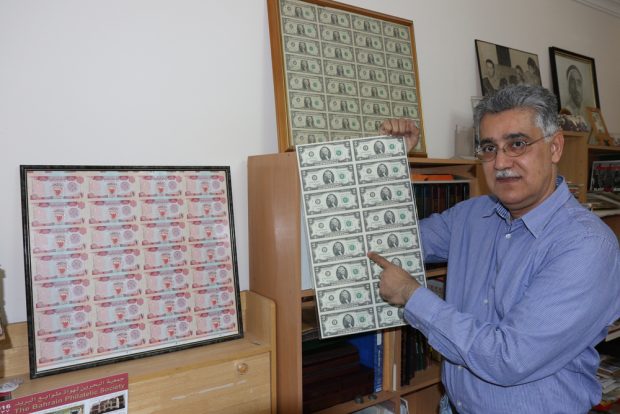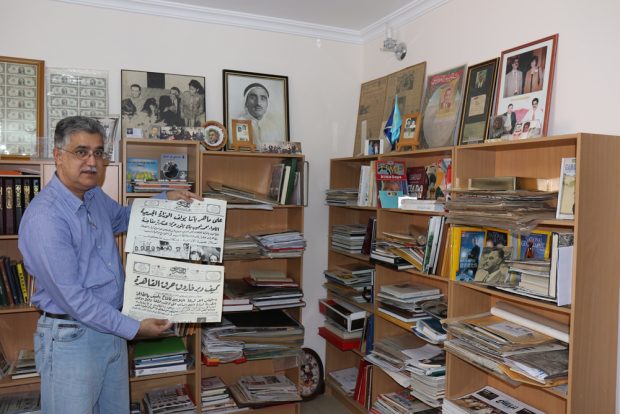Home, Sweet Home: Bahraini collector turns house into museum

At first blush, when people think of museums, images of illustrious storehouses of art and artifacts rush to their minds. However, the case is different when Hafedh Abdul Ghaffar, a Bahraini, is mentioned. He used his home in Saar in the outskirts of the capital Manama to judiciously preserve the past, with all its glory and infamy, fascination and challenges, and expose it for those living in the present and, hopefully, future generations.
Hafedh who describes himself as “immensely passionate about timeless moments of the past” has devoted several rooms for his collection of vintage pictures, old documents, outmoded bottles, rare banknotes and coins, first edition of newspaper front pages that offer rare glimpses into the lifestyles of nations and people, rich and famous, poor and humble, significant and eccentric. As he made his museum, he made sure it would not be a prim and look-but-don’t-touch place. All visitors should feel welcome to dive into the past by looking closely, touching, albeit carefully, and asking questions. His decision has paid off and most of those who have visited it have been humbled by the experience.
The exhibits are as various as awesome. There is an Egyptian newspaper that reports the 1956 attacks by Israel. The different vintage drinking bottles narrate how countries produced them. The passport application displayed in a frame was issued by the Sultanate of Egypt. Another passport was issued by Al Quaiti State (Aden). They are all a source of nostalgia for older generations and awe for the younger ones. Hafedh insists that his aim was not to impress or to use his museum as a lucrative business. “It is there for my family and close friends. I enjoy going through the items because of the strong passion that vibrates within me. It is not and will not be a lucrative business. It is just part of me,” he said.
He recalls how he developed his passion for collecting historic and rare objects during his high school says in the early 1980s. “I liked the old items that could not be found easily. I boosted my interest in collecting money by asking relatives and friends coming back from trips abroad if they could share with me any extra cash from the countries they had visited,” he said. “Gradually I had full sets from several countries and as my passion grew, I wanted to have coins and banknotes from all countries. I then moved on to the next stage. I wanted to have rare and hard to get currency. I thought of countries that broke up and changed their names, such as the Soviet Union, Yugoslavia, and Czechoslovakia.”
Next, he went after full sets of currencies or specimen of currencies that were issued for the first time. “These are a real challenge, but the satisfaction of obtaining them is truly exalting. I recall how I got all the currencies issued by Iraq since it was a kingdom in the 1930s until the post Saddam Husain era.” Another good acquisition was the bank notes carrying repeated numbers, such as 333333 or 555555 or 888888. Touring the room dedicated to currencies, Hafedh points out with pronounced pride to the Russian currencies. The dates are 1780 and 1878. His enthusiasm becomes more obvious when he says that one of his greatest prizes is the $2 bill, the rarest small denomination in the US currency.
The bill was issued in 1776 and discontinued in 1966, but it was resumed in 1976 as part of the United States bicentennial celebration. The bill was last issued in 2003. “I also have a Hungarian Milpengő issued in 1946. The one million pengő bill was meant as a means to deal with the hyperinflation that hit the country following the Great Depression and World War II.” Other multi-zero banknotes in Hafedh’s possession include Turkish lira, Nazi Germany’s one and 10-million banknotes, and Bosnia’s banknotes of 100 million dinaras and 500 million dinaras. Queen Elizabeth also holds a special significance in the room. “I also have a collection of banknotes from several countries with the portrait of Queen Elizabeth on them, such as Canada, New Zealand, Australia, Fiji, Bahamas, Bermuda, Gibraltar, Saint Helena and East Caribbean.”
The queen who succeeded her father in 1952 has been depicted on the banknotes of 33 issuing authorities. “I have steadily developed the habit of going to specialized museums and currency museums whenever I visit a country. I try to purchase currency sheets from central banks, and this is not easy. In fact, it is quite expensive. Lately, I have done it in the US, Malaysia, Iraq, the Philippines, Thailand and Korea. Of course, I was among the lucky few who could get the 28-banknote sheet from Bahrain Central Bank.” Hafedh said that it was highly difficult to put a price on the rare banknotes in the Arab world.

“I am truly proud to have Palestinian pounds in Arabic, English and Hebrew, for instance. Ottoman and Nazi Germany banknotes are also among the most sought-after currencies worldwide. As regards Bahrain, the first issue of the BD5 banknote is quite expensive and may fetch up to BD1,000 today.” Bahrain in October 1965 issued its new banknotes and coins that replaced the Gulf Rupee. The notes denominations were BD10, BD5, BD1, BD1/2 and BD1/4 while the coin denominations were 100fils, 50 fils, 25 fils, 10 fils, five fils and one fils. “In Istanbul, I was fortunate to find a man selling old banknotes and I found the Bahraini notes issued in 1965. I paid him $100 without the slightest hesitation or attempt to bargain.”
Another lucky encounter was in Cairo in 1986 when he found in an antique shop a man selling a banknote issued by the Egyptian government with the serial number 000001. “When I asked about the price, I was so pleased that I paid him much more, telling him to keep the rest. I was concerned he would notice the serial number and comprehend its significance. Obviously, he was not an expert in currencies.” He lived similar adventures as he also collected old stamps, coins, phone cards, vintage documents, newspapers and soda, and juice bottles. A small section in his museum is dedicated to the Philippines.
Being married to a Filipina, Hafedh has invariably used his trips to the Philippines to purchase a wide variety of objects that were popular during the sixties in the Philippines. He rarely lets go of any piece of his collection, and if he does, it is only if he has more than one piece or when he wants to exchange it with a much-coveted coin or banknote. Seeking to share his love for vintage and rare objects, he has now launched Antique, a specialized magazine. And once more, he insists that he is not driven by lucrative gains. “I have strong feelings about old items, and I want to share them with those who care about them as well. The magazine is a forum for all those who want to join in the discussion to highlight the importance of the amazing things of the past and help preserve them safely for the next generations,” he said.
























































